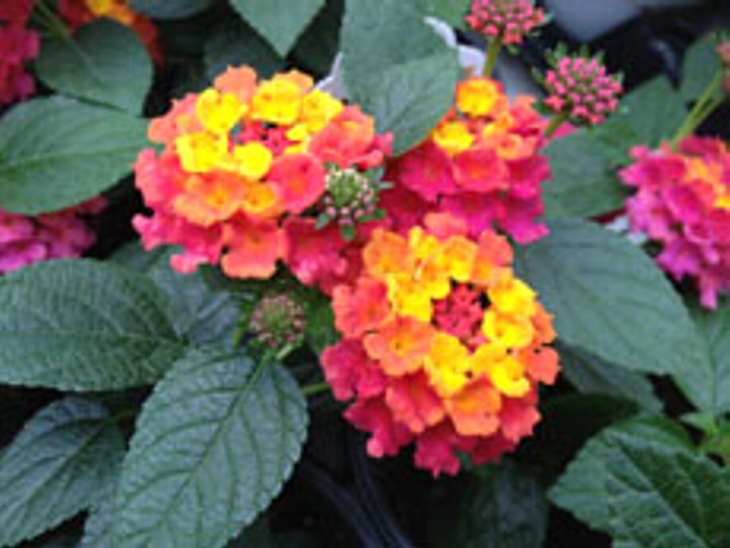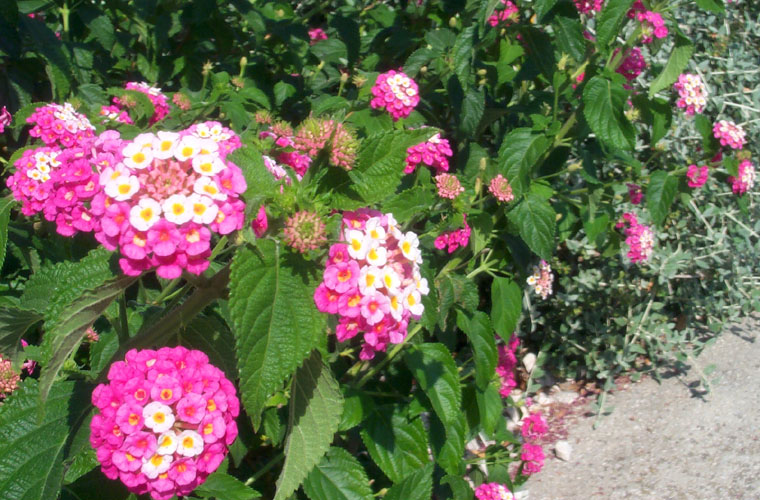| Perennial / Evergreen Shrubs / Lantana camara |
|
|
|
|
| |
|
Plant name - Lantana
|

|
|
 |
|
 |
| Common name - Lantana camara
|
| Plant type - Small Shrub |
| Vegetation type -
Perennial |
| Growth rate - Medium |
| Leaf / Flower color
- Green / purple - yellow |
| Other names - big sage
|
| |
| Description : |
Lantana camara is a small perennial shrub which can grow to around 2m in height and forms dense thickets in a variety of environments. Due to extensive selective breeding throughout the 17th and 18th Century for use as an ornamental plant there are now many different forms of L. camara present throughout the world.
L. camara has small tubular shaped flowers which each have four petals and are arranged in clusters at the end of stems. Flowers come in many different colours including red, yellow, white, pink and orange which differ depending on location, age and maturity. After pollination occurs the colour of the flowers change (typically from yellow to red/pink/orange), this is believed to be a signal to pollinators that the pre-change colour contains a reward as well as being sexually viable, thus increasing pollination efficiency.
The leaves are egg-shaped, simple, arranged oppositely on the stem and have a strong odour when crushed.
The fruit of L. camara is berry-like and turns a deep purple colour when mature. Both vegetative (asexual) and seed reproduction occur. Up to 12,000 fruits can be produced by each plant which are then eaten by birds and other animals which can spread the seeds over large distances, facilitating the spread of L. camara.
|
| |
| Growing Instructions : |
* Place the Lantana camara seeds in a bowl of warm water for three days, changing the water daily.
* Choose a germination container. If you are planting many seeds, a nursery flat is ideal. For smaller plantings, use nursery pots. Fill the container with a peat-based seeding mix, available at commercial nurseries and online retailers.
* Place the Lantana camara seeds on the surface of the mix, and sprinkle sand or vermiculite over them until they are barely covered. The seeds need light to germinate, so don't bury them. Cover the container with plastic wrap, or insert it into a plastic bag and seal it.
* Place the heat mat in an area with bright but indirect sunlight. Set the thermostat to 75 degrees Fahrenheit, and place the container on top of it. The plastic should act as a greenhouse and keep moisture in the soil, but check the soil periodically and dribble water over it if it is drying out. Germination may be erratic, but the seeds should sprout from within 14 to 80 days.
* Remove the plastic wrap or bag when the Lantana camara seeds sprout. Keep the soil moist, and allow the container to remain in the same area.
* Transplant the lantana seedlings into the garden when the air temperature remains at 75 degrees Fahrenheit or above. Pick a sunny spot, loosen the soil and plant the seedlings at the same depth that they were growing in the germination container.
* Keep the soil moist as the seedlings become established. When you notice new growth, begin decreasing how often you water the plants until you are giving them 1 inch of water a week. Although lantana is drought-tolerant, you will get more flowers if you water the plant consistently.
|
| |
|
|
|
|
|
